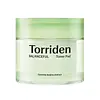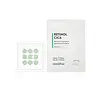What's inside
What's inside
 Key Ingredients
Key Ingredients

 Benefits
Benefits

 Concerns
Concerns

 Ingredients Side-by-side
Ingredients Side-by-side

Water
Skin ConditioningDipropylene Glycol
HumectantButylene Glycol
HumectantGluconolactone
Skin ConditioningPanthenol
Skin ConditioningAllantoin
Skin ConditioningSodium Hyaluronate
HumectantCentella Asiatica Extract
CleansingMadecassoside
AntioxidantAsiatic Acid
Skin ConditioningMadecassic Acid
Skin ConditioningAsiaticoside
AntioxidantCapryloyl Salicylic Acid
ExfoliatingHamamelis Virginiana Extract
AntiseborrhoeicAlthaea Rosea Flower Extract
Skin ConditioningNymphaea Caerulea Flower Extract
Skin ConditioningSwertia Japonica Extract
Skin ConditioningLactobacillus Ferment
Skin ConditioningGlycerin
HumectantHydroxyacetophenone
AntioxidantPantolactone
HumectantPolyglyceryl-10 Laurate
Skin ConditioningGlyceryl Acrylate/Acrylic Acid Copolymer
HumectantPvm/Ma Copolymer
Emulsion StabilisingHydrogenated Phosphatidylcholine
EmulsifyingSucrose Stearate
EmollientSodium Guaiazulene Sulfonate
Caprylic/Capric Triglyceride
MaskingCaprylyl Glycol
EmollientCholesterol
EmollientArginine
MaskingMelia Azadirachta Flower Extract
Skin ConditioningMelia Azadirachta Leaf Extract
Skin ConditioningDipotassium Glycyrrhizate
Humectant1,2-Hexanediol
Skin ConditioningDisodium EDTA
Ethylhexylglycerin
Skin ConditioningWater, Dipropylene Glycol, Butylene Glycol, Gluconolactone, Panthenol, Allantoin, Sodium Hyaluronate, Centella Asiatica Extract, Madecassoside, Asiatic Acid, Madecassic Acid, Asiaticoside, Capryloyl Salicylic Acid, Hamamelis Virginiana Extract, Althaea Rosea Flower Extract, Nymphaea Caerulea Flower Extract, Swertia Japonica Extract, Lactobacillus Ferment, Glycerin, Hydroxyacetophenone, Pantolactone, Polyglyceryl-10 Laurate, Glyceryl Acrylate/Acrylic Acid Copolymer, Pvm/Ma Copolymer, Hydrogenated Phosphatidylcholine, Sucrose Stearate, Sodium Guaiazulene Sulfonate, Caprylic/Capric Triglyceride, Caprylyl Glycol, Cholesterol, Arginine, Melia Azadirachta Flower Extract, Melia Azadirachta Leaf Extract, Dipotassium Glycyrrhizate, 1,2-Hexanediol, Disodium EDTA, Ethylhexylglycerin
Trehalose
HumectantSodium Hyaluronate
HumectantCellulose Gum
Emulsion StabilisingGlycerin
HumectantPolyglyceryl-10 Laurate
Skin ConditioningGlycine Soja Oil
EmollientAllantoin
Skin ConditioningDipotassium Glycyrrhizate
HumectantAdenosine
Skin ConditioningRetinol
Skin ConditioningMadecassoside
AntioxidantHyaluronic Acid
HumectantSalicylic Acid
MaskingWater
Skin ConditioningAsiaticoside
AntioxidantMadecassic Acid
Skin ConditioningAsiatic Acid
Skin ConditioningBHT
AntioxidantPropanediol
Solvent1,2-Hexanediol
Skin ConditioningCentella Asiatica Flower/Leaf/Stem Extract
Skin ConditioningEthylhexylglycerin
Skin ConditioningDisodium EDTA
Trehalose, Sodium Hyaluronate, Cellulose Gum, Glycerin, Polyglyceryl-10 Laurate, Glycine Soja Oil, Allantoin, Dipotassium Glycyrrhizate, Adenosine, Retinol, Madecassoside, Hyaluronic Acid, Salicylic Acid, Water, Asiaticoside, Madecassic Acid, Asiatic Acid, BHT, Propanediol, 1,2-Hexanediol, Centella Asiatica Flower/Leaf/Stem Extract, Ethylhexylglycerin, Disodium EDTA
 Reviews
Reviews

Ingredients Explained
These ingredients are found in both products.
Ingredients higher up in an ingredient list are typically present in a larger amount.
1,2-Hexanediol is a synthetic liquid and another multi-functional powerhouse.
It is a:
- Humectant, drawing moisture into the skin
- Emollient, helping to soften skin
- Solvent, dispersing and stabilizing formulas
- Preservative booster, enhancing the antimicrobial activity of other preservatives
Allantoin is a soothing ingredient known for its protective and moisturizingg properties. Because of this, it is often added to products with strong active ingredients.
Studies show higher concentrations of this ingredient can promote wound healing.
Though it can be derived from the comfrey plant, allantoin is produced synthetically for cosmetic products to ensure purity.
Learn more about AllantoinAsiatic Acid is a major component of Centella Asiatica Extract. It has wound-healing, anti-inflammatory, and antioxidant properties.
Studies show Asiatic Acid is able to block the pathway for skin inflammation receptors, helping to soothe skin.
As an antioxidant, asiatic acid helps protect our skin against damaging environmental factors.
Learn more about Asiatic AcidAsiaticoside comes from the super popular skin-soothing ingredient, Centella asiatica. It is one of four active compounds found in the extract of Centella Asiatica.
Asiaticoside is an antioxidant and helps with wound healing. It has been shown to increase antioxidant activity during the wound healing process.
Dipotassium Glycyrrhizate comes from licorice root.
Extracts of licorice have demonstrated to have antibacterial, anti‐inflammatory, antiviral, antioxidant properties.
One component, glabridin, has extra potent antioxidant and soothing properties. It has also been found to block pigmentation from UVB rays in guinea pigs.
Licorice Root also contains a flavonoid. Flavonoids are a natural substance from in plants. Flavonoids also have antioxidant properties.
Another component, glycyrrhizin, has been found to have anti-inflammatory and antimicrobial benefits. This may make licorice root extract effective at treating acne. However, more research is needed to support this.
Liquiritin is one of the flavone compounds found in licorice. It has been found to help lighten skin by preventing tyrosinase from reacting with tyrosine. When the two react, protein is converted to melanin. Melanin is the substance in your body that gives your features pigmentation.
Licorice root is native to Southern Europe and Asia. It has been used in traditional Chinese medicine to help with respiratory issues.
Learn more about Dipotassium GlycyrrhizateDisodium EDTA plays a role in making products more stable by aiding other preservatives.
It is a chelating agent, meaning it neutralizes metal ions that may be found in a product.
Disodium EDTA is a salt of edetic acid and is found to be safe in cosmetic ingredients.
Learn more about Disodium EDTAEthylhexylglycerin (we can't pronounce this either) is commonly used as a preservative and skin softener. It is derived from glyceryl.
You might see Ethylhexylglycerin often paired with other preservatives such as phenoxyethanol. Ethylhexylglycerin has been found to increase the effectiveness of these other preservatives.
Glycerin is already naturally found in your skin. It helps moisturize and protect your skin.
A study from 2016 found glycerin to be more effective as a humectant than AHAs and hyaluronic acid.
As a humectant, it helps the skin stay hydrated by pulling moisture to your skin. The low molecular weight of glycerin allows it to pull moisture into the deeper layers of your skin.
Hydrated skin improves your skin barrier; Your skin barrier helps protect against irritants and bacteria.
Glycerin has also been found to have antimicrobial and antiviral properties. Due to these properties, glycerin is often used in wound and burn treatments.
In cosmetics, glycerin is usually derived from plants such as soybean or palm. However, it can also be sourced from animals, such as tallow or animal fat.
This ingredient is organic, colorless, odorless, and non-toxic.
Glycerin is the name for this ingredient in American English. British English uses Glycerol/Glycerine.
Learn more about GlycerinMadecassic Acid is a major component of Centella Asiatica Extract. It has anti-inflammatory and antioxidant properties.
It is a triterpenoid, meaning it naturally acts as an antioxidant. Antioxidants protect your skin against damage from environmental factors such as pollution and UV.
Studies show Madecassic Acid helps soothe the skin due to its ability to block inflammation pathways.
Learn more about Madecassic AcidMadecassoside comes from the super popular skin-soothing ingredient, Centella asiatica. It is one of four active compounds found in the extract of Centella Asiatica.
Madecassoside has antioxidant, anti-inflammatory, and hydrating properties. It contains fatty acids, amino acids, beta-carotene, and phytochemicals.
One study found using Madecassoside with ascorbic acid helped reduce the signs of aging and improved skin hydration.
Learn more about MadecassosidePolyglyceryl-10 Laurate is an ester of lauric acid and Polyglycerin-10.
Polyglyceryl-10 Laurate is a cleansing agent and emulsifier. It helps gather dirt, oil, and other pollutants to be rinsed away. As an emulsifier, it helps prevent ingredients from separating, such as oil and water.
Polyglyceryl-10 Laurate may not be fungal acne safe.
Learn more about Polyglyceryl-10 LaurateSodium Hyaluronate is hyaluronic acid's salt form. It is commonly derived from the sodium salt of hyaluronic acid.
Like hyaluronic acid, it is great at holding water and acts as a humectant. This makes it a great skin hydrating ingredient.
Sodium Hyaluronate is naturally occurring in our bodies and is mostly found in eye fluid and joints.
These are some other common types of Hyaluronic Acid:
Learn more about Sodium HyaluronateWater. It's the most common cosmetic ingredient of all. You'll usually see it at the top of ingredient lists, meaning that it makes up the largest part of the product.
So why is it so popular? Water most often acts as a solvent - this means that it helps dissolve other ingredients into the formulation.
You'll also recognize water as that liquid we all need to stay alive. If you see this, drink a glass of water. Stay hydrated!
Learn more about Water